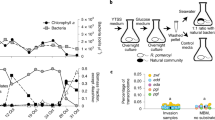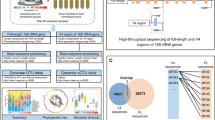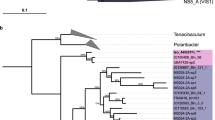Abstract
Hutchinson’s fundamental niche, defined by the physical and biological environments in which an organism can thrive in the absence of inter-species interactions, is an important theoretical concept in ecology. However, little is known about the overlap between the fundamental niche and the set of conditions species inhabit in nature, and about natural variation in fundamental niche shape and its change as species adapt to their environment. Here, we develop a custom-made dual gradient apparatus to map a cross-section of the fundamental niche for several marine bacterial species within the genus Vibrio based on their temperature and salinity tolerance, and compare tolerance limits to the environment where these species commonly occur. We interpret these niche shapes in light of a conceptual model comprising five basic niche shapes. We find that the fundamental niche encompasses a much wider set of conditions than those strains typically inhabit, especially for salinity. Moreover, though the conditions that strains typically inhabit agree well with the strains’ temperature tolerance, they are negatively correlated with the strains’ salinity tolerance. Such relationships can arise when the physiological response to different stressors is coupled, and we present evidence for such a coupling between temperature and salinity tolerance. Finally, comparison with well-documented ecological range in V. vulnificus suggests that biotic interactions limit the occurrence of this species at low-temperature—high-salinity conditions. Our findings highlight the complex interplay between the ecological, physiological and evolutionary determinants of niche morphology, and caution against making inferences based on a single ecological factor.
Similar content being viewed by others
Log in or create a free account to read this content
Gain free access to this article, as well as selected content from this journal and more on nature.com
or
References
Boucher Y, Cordero OX, Takemura A, Hunt Dana E, Schliep K, Bapteste E et al (2011). Local mobile gene pools rapidly cross species boundaries to create endemicity within global Vibrio cholerae populations. mBio 2: e00335–10.
Boucher Y, Nesbø CL, Joss MJ, Robinson A, Mabbutt BC, Gillings MR et al (2006). Recovery and evolutionary analysis of complete integron gene cassette arrays from Vibrio. BMC Evol Biol 6: 3.
Chase JM, Leibold MA . (2003) Ecological Niches: Linking Classical and Contemporary Approaches. University of Chicago Press: Chicago.
Diez-Gonzalez F, Kuruc J . (2009). Molecular mechanisms of microbial survival in foods. In: Jaykus L-A, Wang HH, Schlesinger LS (eds) Food-Borne Microbes: Shaping the Host Ecosystem. ASM Press: Washington, DC, pp 135–159.
Edgar RC . (2004). MUSCLE: a multiple sequence alignment method with reduced time and space complexity. BMC Bioinformatics 5: 113.
Emerson S, Hedges J . (2008) Chemical Oceanography and the Marine Carbon Cycle. Cambridge University Press: Cambridge.
Felsenstein J . (1985). Phylogenies and the comparative method. Am Nat 125: 1–15.
Garland T, Bennett AF, Rezende EL . (2005). Phylogenetic approaches in comparative physiology. J Exp Biol 208: 3015–3035.
Garland T, Harvey PH, Ives AR . (1992). Procedures for the analysis of comparative data using phylogenetically independent contrasts. Syst Biol 41: 18–32.
Garrity GM, Brenner DJ, Krieg NR . (2005) Bergey’s Manual Of Systematic Bacteriology. Springer: New York.
Gessner P . (1995). Isobolographic analysis of interactions: an update on applications and utility. Toxicology 105: 161–179.
Guindon S, Lethiec F, Duroux P, Gascuel O . (2005). PHYML Online--a web server for fast maximum likelihood-based phylogenetic inference. Nucleic Acids Res 33: W557–W559.
Hengge-Aronis R . (2002). Signal transduction and regulatory mechanisms involved in control of the sigma(S) (RpoS) subunit of RNA polymerase. Microbiol Mol Biol Rev 66: 373–395.
Herlemann DP, Labrenz M, Jurgens K, Bertilsson S, Waniek JJ, Andersson AF . (2011). Transitions in bacterial communities along the 2000km salinity gradient of the Baltic Sea. ISME J 5: 1571–1579.
Holt RD . (2009). Bringing the Hutchinsonian niche into the 21st century: Ecological and evolutionary perspectives. Proc Natl Acad Sci USA 106: 19659–19665.
Hooper HL, Connon R, Callaghan A, Fryer G, Yarwood-Buchanan S, Biggs J et al (2008). The ecological niche of Daphnia magna characterized using population growth rate. Ecology 89: 1015–1022.
Hunt DE, David LA, Gevers D, Preheim SP, Alm EJ, Polz MF . (2008). Resource partitioning and sympatric differentiation among closely related bacterioplankton. Science 320: 1081–1085.
Hutchinson GE . (1957). Concluding remarks. Cold Spring Harbor Symp Quant Bio 22: 415–427.
Ives AR, Midford PE, Garland T . (2007). Within-species variation and measurement error in phylogenetic comparative methods. Syst Biol 56: 252–270.
Kaspar CW, Tamplin ML . (1993). Effects of temperature and salinity on the survival of Vibrio vulnificus in seawater and shellfish. Appl Environ Microbiol 59: 2425.
Keith CT, Borisy AA, Stockwell BR . (2005). Multicomponent therapeutics for networked systems. Nat Rev Drug Discov 4: 71–78.
Leibold MA . (1995). The niche concept revisited: mechanistic models and community context. Ecology 76: 1371–1382.
Lozupone CA, Knight R . (2007). Global patterns in bacterial diversity. Proc Natl Acad Sci 104: 11436–11440.
May R, MacArthur R . (1972). Niche overlap as a function of environmental variability. Proc Natl Acad Sci USA 69: 1109–1113.
McCarthy SA . (1996). Effects of temperature and salinity on survival of toxigenic Vibrio cholerae O1 in seawater. Microb Ecol 31: 167–175.
McDougald D, Kjelleberg S . (2006). Adaptive responses to Vibrios. In: Thompson F, Austin B, Swings J (eds) The Biology of Vibrios. ASM Press: Washington, DC, pp 133–155.
Naeem S, Colwell RK . (1991). Ecological consequences of heterogeneity of consumable resources. In: Kolasa J, Pickett STA (eds) Ecological Heterogeneity. Springer-Verlag: New York, pp 224–255.
Panagou EZ, Skandamis PN, Nychas G-JE . (2005). Use of gradient plates to study combined effects of temperature, pH, and NaCl concentration on growth of Monascus ruber van Tieghem, an Ascomycetes fungus isolated from green table olives. Appl Environ Microbiol 71: 392–399.
Preheim SP, Timberlake S, Polz MF . (2011). Merging taxonomy with ecological population prediction in a case study of Vibrionaceae. Appl Environ Microbiol 77: 7195–7206.
Randa MA, Polz MF, Lim E . (2004). Effects of temperature and salinity on Vibrio vulnificus population dynamics as assessed by quantitative PCR. Appl Environ Microbiol 70: 5469–5476.
Rosche TM, Smith DJ, Parker EE, Oliver JD . (2005). RpoS involvement and requirement for exogenous nutrient for osmotically induced cross protection in Vibrio vulnificus. FEMS Microbiology Ecology 53: 455–462.
Soto W, Gutierrez J, Remmenga MD, Nishiguchi MK . (2009). Salinity and temperature effects on physiological responses of Vibrio fischeri from diverse ecological niches. Microb Ecol 57: 140–150.
Stanley SO, Morita RY . (1968). Salinity effect on the maximal growth temperature of some bacteria isolated from marine environments. J Bacteriol 95: 169–173.
Thompson FL, Iida T, Swings J . (2004a). Biodiversity of vibrios. Microbiol Mol Biol Rev 68: 403.
Thompson JR, Pacocha S, Pharino C, Klepac-Ceraj V, Hunt DE, Benoit J et al (2005). Genotypic diversity within a natural coastal bacterioplankton population. Science 307: 1311–1313.
Thompson JR, Randa MA, Marcelino LA, Tomita-Mitchell A, Lim E, Polz MF et al (2004b). Diversity and dynamics of a North Atlantic Coastal Vibrio community. Appl Environ Microbiol 70: 4103–4110.
Tilman D . (1982) Resource Competition and Community Structure. Princeton University Press: Princeton.
Urakawa H, Rivera I . (2006). Aquatic environment. In: Thompson F, Austin B, Swings J (eds) The Biology of Vibrios. ASM Press: Washington, DC, pp 175–189.
Whittaker RH, Levin SA, Root RB . (1973). Niche, habitat, and ecotope. Am Nat 107: 321–338.
Yeh P, Tschumi AI, Kishony R . (2006). Functional classification of drugs by properties of their pairwise interactions. Nat Genet 38: 489–494.
Author information
Authors and Affiliations
Corresponding author
Additional information
Supplementary Information accompanies the paper on The ISME Journal website
Supplementary information
Rights and permissions
About this article
Cite this article
Materna, A., Friedman, J., Bauer, C. et al. Shape and evolution of the fundamental niche in marine Vibrio. ISME J 6, 2168–2177 (2012). https://doi.org/10.1038/ismej.2012.65
Received:
Revised:
Accepted:
Published:
Issue date:
DOI: https://doi.org/10.1038/ismej.2012.65
Keywords
This article is cited by
-
What is the shape of the fundamental Grinnellian niche?
Theoretical Ecology (2020)



